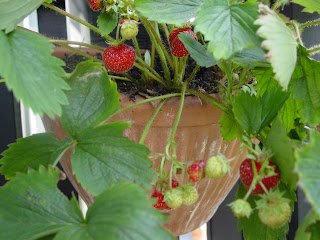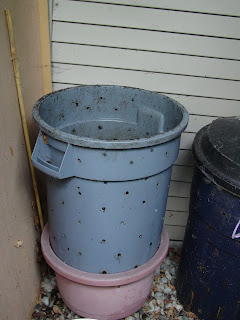Composters Alert! Here is your opportunity to benefit from all the hard work done by others. On a Sunday afternoon, jump in your vehicle and cruise the neighbourhood. Look for subdivisions with leafy trees. I have a personal favourite.

I have no idea what they are! They are the first trees to bow out in fall with a magnificent display of sunny yellow. I anticipate and greatly enjoy the show every year, however, from a discerning composter's perspective, I appreciate the small compound leaves, that do not mat in the compost bin and break down quickly, contributing their carbon to the mix, just as much!
So now is the time to get out in your neighbourhood, late on a Sunday afternoon, and toss neatly packaged bags of leaves into you trunk! (If all is in your favour, it will not have rained for a couple of days before the homeowners decided to undertake this yearly chore and the leaves will be dry.) Collect what you might consider to be a year's supply for you to add to you compost with each new addition of kitchen waste. Such a mix will break down to give you a well rounded blend of nutritious plant food in a few months.
I have upped my year's supply to four bags. I find that is what I need to take me through until the leaves fall again next year. This year I had to resort to a bag of grass clippings, when I ran out too soon. Grass clippings are great if you are sure that your supplier has not added any nefarious substances, which I was not.

I acquired a pretty blue rain barrel with no lid which I will use this year to store two bags of leaves. That way the leave will be better ventilated and can dry out. I will open the top of the other bags to air them out as the the leaves are still damp. It is a good idea to punch random holes in the sides of the bag so moisture can escape. You want to avoid encouraging mold. The open top of the bag of leaves doubles as a great nest for friend Mottlee when he spends those cold, winter night outside, which he so seems to enjoy.
FALL BOUNTY:
I stopped at a huge fruit stand somewhere just out of Keremeos called Mariposa Orchards (250-499-2749) on the long drive back from Kelowna to Richmond about two weeks ago. I spent over an hour there inspecting the wonderful fall bounty - huge crates of multiple varieties of peppers, apples, pears, potatoes and onions. All kinds of pumpkins, squashes, gourds and translucent ears of popping corn in pale yellow and pink. A huge array of jams, jellies and honeys. The Okanagan is a bountiful indeed! What a feast for the eyes!

As I was planning a Fall Feast and celebration for my hubby's b/day a week later, I decided to stock up.

A Gift for my Feathered Friends:
Actually two gifts. I also bought a bottle gourd in Keremeos which I plan to dry, drill and turn into a bird house and make it avaialble as a FREE residence for a lucky neighbourhood couple to raise a little family.
I also purchased a wonderful large sunflower head, chock full of white seeds neatly packed in swirls around the sunflower's face. Have you ever looked closely at a sunflower's face? Inspiring and wonderous. Inspires hope in universal intelligence and creativity!
I pierced the back of the sunflower with a skewer and suspended it from a leather thong and hung it just outside the kitchen window where I can observe who comes for the seeds. I have not been disappointed. Despite the threat of two cats lurking about, two brave little chickadees have been flying in, and methodically removing seeds, one by one. Soon the sunflower will look like a Yin Yang icon. Half light, half dark.

Salad Greens:
The clay bowl of salad greens I replanted in early fall have grown but quickly bolted. All the cruciferous ('with four equal petals arranged crosswise')family - patchoy, etc, (or is it cole family?)seem to be aware that their days in the sun are short lived. The bees have been coming by and enjoying this small,late season supply of nectar. I also added some, not all (left some for the bees) of the flowers to a festive salad, they are quite sweet.

Fall is Bittersweet:
Every season has its gifts, bounty and beauty. It is a question of paying attention so one can see them coming.


Happy Fall!










































